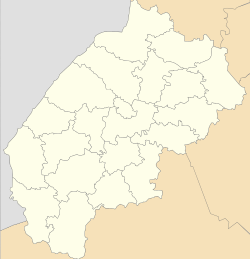Boryslav
|
Boryslav Борислав |
|||
|---|---|---|---|
| City of regional significance | |||

Church of St. Anne
|
|||
|
|||
| Location of Boryslav | |||
| Coordinates: 49°17′21″N 23°25′08″E / 49.28917°N 23.41889°ECoordinates: 49°17′21″N 23°25′08″E / 49.28917°N 23.41889°E | |||
| Country | Ukraine | ||
| Oblast | Lviv Oblast | ||
| Municipality | Boryslav | ||
| First mentioned | 1387 | ||
| Government | |||
| • Mayor | Volodymyr Firman | ||
| Area | |||
| • Total | 37.0 km2 (14.3 sq mi) | ||
| Population (2016) | |||
| • Total | 34 392 | ||
| Website | www.boryslavmvk.gov.ua | ||
Boryslav (Ukrainian: Борислав, Polish: Borysław) is a city located on the (a tributary of the Dniester), in Lviv Oblast (region) of western Ukraine. Boryslav is designated as a city of oblast significance. It is a major center of petroleum industry. Population: 34,392 (2016 est.).
The area of the modern town of Boryslav has been inhabited at least since the Bronze Age. There are remnants of a pagan shrine from the 1st millennium BC located in the area, where approximately 270 petroglyphs are found, mostly depicting solar signs - symbols of a pre-Christian Solar deity. Between the 9th and 13th centuries, the site of the modern town housed a fortress named Tustan, which was part of a belt of similar strongholds defending the Kievan Rus' from the west and south. After the dissolution of Kievan Rus', the town became a part of the Halych-Volhynian Principality. With the collapse of the latter, in the 14th century Boryslav became a part of the Crown of the Kingdom of Poland. It was first mentioned in a document from 19 March 1387, listing all personal belongings of Queen regnant Jadwiga of Poland.
Since that time, Borysław, as it was then called, was a small town related to the nearby metropolis of Lwów (currently Lviv, Ukraine) and mostly shared its fate. In 1772, during the Partitions of Poland, it was annexed by Austria and became a part of the Austrian Kingdom of Galicia and Lodomeria. One of the great technological developments of the 19th century was the discovery by pharmacist Johan (Jan) Zeh (1817–1897, in nearby Lviv) of technology that led to the establishment of a new industry based on petroleum. Scientists worked out a method of distilling Boryslaw crude oil, and on 30 March 1853 made the first kerosene lamp. As early as 31 July 1853 their new lamp was used to illuminate the Public Hospital in Lvov. Their discoveries marked the beginnings of the rapid search for petroleum in the Carpathians—especially in the eastern sector of the mountain chain where rich oil deposits were discovered. In 1854 the first ozokerite mine was started in the town after the ore was discovered by Robert Doms. In the second half of 1853, following the research of Jan Zeh, and several other scientists working in the nearby city of Lemberg, the town and its surroundings saw the emergence of an oil industry. One of the first oil rigs in the world was built near Boryslav by Robert Doms in 1861. The oil and mining industries developed quickly. In 1909, more than 1,920,000 tonnes of oil were produced in the region—roughly 5% of the world's oil production at that time. The number of oil rigs also rose from 4,000 in 1870 to over 12,000 three years later. The oil boom drew many industry moguls from all over Austria-Hungary and many fortunes were earned and lost there. A period of prosperity saw the city's population grew as almost 10,000 new workers arrived to the area. In 1886 an oil mining school was opened in Borysław, one of the first such facilities in Europe. Also the ozokerite, a natural mineral wax, mined in Borysław, was used for insulation of the first trans-Atlantic telegraphic cable line. On 31 December 1872, a railway line linking Borysław with the nearby city of Drohobycz (now Drohobych, Ukraine) was opened.
...
Wikipedia




